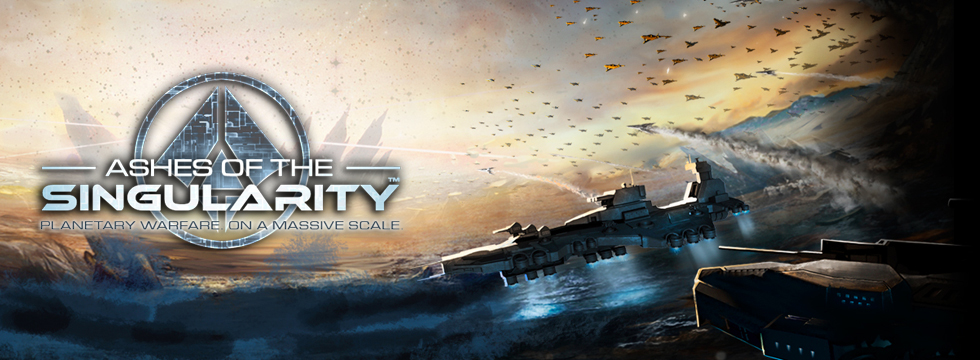author: Sly
Ashes of the Singularity Impressions - A smart combination of Company of Heroes and Total Annihilation
The latest game from studio Stardock is mostly known for the fact that it's the first DirectX 12 benchmark. The early beta of Ashes of the Singularity proves that it's also an RTS with interesting mechanics.
Read the review Ashes of the Singularity Review – strategy, tactics, and bipolar AI
This text was based on the PC version.
CONTENT OF EARLY ACCESS
- one race;
- 15 combat units;
- 12 buildings;
- one game mode;
- enhanced AI – as many as 7 levels of difficulty;
- skirmish and multiplayer mode;
- built-in benchmark.
The alpha version of the game Ashes of the Singularity presents a considerable challenge to strategy vets and proves that we can still find productions that are like a breath of fresh air to the genre. An RTS set in the future that doesn't focus on fast, arcade action reminiscent of StarCraft is a great rarity these days. Clashes of epic proportions, sophisticated intelligence of computer-controlled opponents, and meta-unit mechanism are the three elements emphasized in the production from studio Stardock. Apart from that, AotS is also an interesting real-time strategy, which already at the stage of early access provides many hours of fun. It’s one of the productions in which the mere fact of improving our skills is so addictive that we can’t break away from the monitor.

Step 1 – follow the best

American studio Stardock mostly creates strategy games, within the broad meaning of the term, in various settings. Suffice it to say that their portfolio includes, apart from series such as Galactic Civilizations (sci-fi) and Elemental (fantasy), the cycle Political Machine (where we control the presidential campaign in the US) or The Corporate Machine (economic strategy).
Ashes of the Singularity is certainly not a game that revolutionizes the RTS genre. The developers themselves say that it's more of a combination of various solutions borrowed from other titles: taking over regions from Company of Heroes, transferring resources in real time (rather than paying in advance for a unit or a building) known from Total Annihilation, or interacting with the map modeled on Sins of a Solar Empire. However, it cannot be said that the game lacks its own characteristics. Stardock went for the epicness, and it's true that everything in this game is enormous – maps, armies and, most of all, the number of different actions that we need to control simultaneously.
In the alpha we only have one available race, the "Post Human Coalition" (without orbitals), a dozen boards, and one game mode. Doesn't seem like much, but in fact it's quite enough to spend a couple of enjoyable hours with the game. The developers warn us not to underestimate the artificial intelligence; they encourage the players to try their luck with one opponent on the easiest difficulty level first, and then gradually climb up. Indeed, it’s a good solution, as it helps to calmly explore the mechanics of the game. The second aspect that allows us to have more fun with the early version of the game is, of course, the multiplayer mode.
Unfortunately, here I was met with disappointment. During several dozen attempts I could count the number of players willing to fight on one hand; the first one immediately walked out of the lobby; I was able to start a match with the second one, but then I received an error message. Subsequent attempts weren't much better which is a pity as the game has the potential to be a really interesting multiplayer strategy. Let us hope that these are just the Early Access version shortcomings.
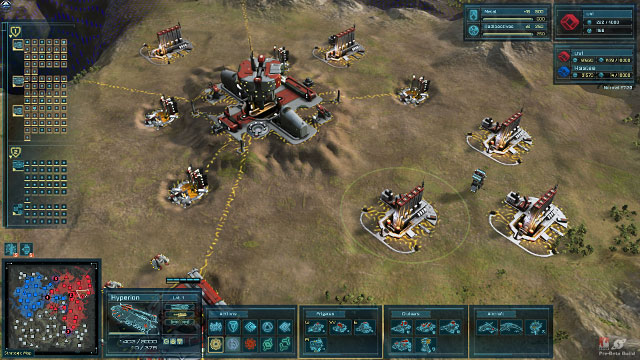
Step 2 – excel at multitasking
Multitasking seems to be a talent of key importance for those who want to succeed in Ashes of the Singularity. Of course, it’s vital in any real-time strategy, but it was here that I felt for the first time what it means to fight on a several or even dozen fronts simultaneously. How was this possible? Among other things, thanks to the meta-unit system. By grouping our army we create individual and virtually independent troops. The trick is to connect units so that they will complement each other on the battlefield. In addition to creating meta-units, our responsibility is to direct them in the right places – to protect key positions, attack the enemy, or take over strategic points that enlarge our territory and provide additional resources.

In RTSs such as StarCraft we control individual troops and our multitasking efforts occur within a single unit (using individual skills, attacking specific targets); in Ashes of the Singularity this perspective changes. We control entire armies which choose their own goals and use their abilities independently. In turn, the players assume the roles of generals who outline the strategies of conquest.
Surprisingly, this distanced perspective works perfectly. To be honest, it’s always bothered me a little bit in classic RTSs that almost every unit had its own ability that had to be activated, which in the turmoil of war was often a difficult thing to do at the right time. It was sometimes equally hard to work out exactly which target should be attacked at a given moment, how many units remained, and what was actually happening on the screen. RTS veterans probably didn't find it problematic, but to me this chaos was sometimes overwhelming. In this respect, Stardock's game seems to be more transparent. The main difficulty is thus not commanding the units during various clashes, but finding an appropriate strategy for base development, unit production and formation of meta-units, and then planning the movements of the army so as to swiftly take over and keep as many as possible strategic points.

The abovementioned game mechanics impose a slower pace of the gameplay. This mostly boils down to the speed of units – if they moved as fast as they do in a typical real-time strategy, it would be impossible to deal with so many things simultaneously, even despite the partial independence of our units. However, I feel that the developers somewhat overdid this aspect and the armies move too sluggishly, on top of that not always responding to commands issued. I'm not sure whether it is a matter of said pace of the game or some technical problems, but sometimes I had to issue commands to troops several times to finally have them obey me and do what I expected of them. And it wasn't a problem of poor morale.
Step 3 – avoid overcomplicating things
Ashes of the Singularity doesn't feature overly complicated mechanics. At least at this stage – perhaps the situation will change once orbital structures or additional global skills are introduced. In fact, the mechanics of development boil down to building four types of units – frigates, cruisers, dreadnoughts and aircraft (in total there are 14 of them plus Engineer) – and defense towers as well as buildings extracting raw materials. We can win by destroying enemy main base or earning a certain amount of victory points (Turinium). The latter we can obtain for maintaining specific buildings on the map. As you can see, fans of extensive strategies may be slightly disappointed. On the other hand, chess apparently aren't complicated either, but nobody would say that it doesn’t require strategic thinking. The analogy to chess is not accidental, because these games have something in common. Of course, the title from Stardock is not turn-based, but it contains a similar rule of action-reaction, and the map is filled with strategic points that bear a slight resemblance to a chess board.
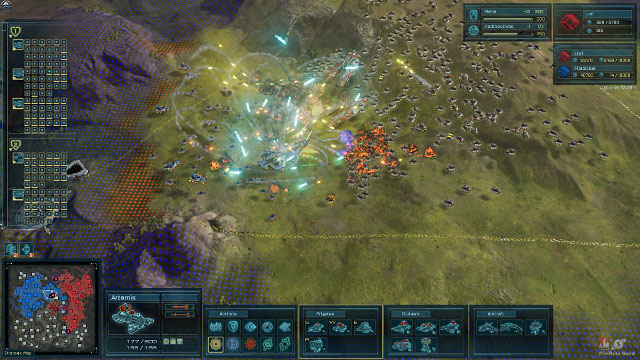
Step 4 – don't make promises you can't keep
While playing the early version of AotS we’re able to verify most of the promises made by the devs. Indeed, they managed to create a game featuring large-scale conflicts – that is, involving thousands of units. It should be noted, however, that the size of battles depends not only on the type of map we choose, but also the number of Turinium points required to win the war. The smaller the map and the lower the point threshold, the more modest the battle will be, and the gameplay will become more classical. Big maps with plenty of Turinium points and six opponents are a guarantee of a long and exciting challenge. Stardock also assured us that it would create an RTS that mostly consists in strategic thinking rather than the speed of mouse clicks. True, the tactics and multitasking in this game are essential, but we mustn't forget that the efficiency of issuing commands – especially in the early stages of development – is equally important. At this stage it's hard to make a full assessment of the artificial intelligence, which, according to the devs’ assurances, is to be extremely smart, and won't cheat. One cannot deny, however, that on higher difficulty levels the AI can make our life a living hell.
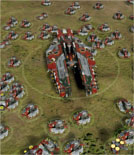
The creators have promised that tens of thousands of units will be able to fight each other at a time, so we decided to see whether it was at all possible. The limit of the armies is determined by the number of Logistics points. The troop that is cheapest in this regard (Hermes, Archer or Brute) costs one point of Logistics and consists of three units. The base number of Logistics at the start the game amounts to 100 points, but during the game we can increase this number through appropriate technology improvements. And here comes the most interesting thing – despite my strenuous attempts I failed to discover what was the maximum limit of Logistics points. I was able to reach 6,000 and could still buy more points. It is easy to calculate that 6,000 Hermes troops gives us 18,000 units per army. This is the theory, because in practice the production (not to mention the management and efficiency) of so many units is virtually impossible to attain due to cost and time. However, this doesn't change the fact that the developers kept their promise.
A little far-fetched, in turn, is the talk about clashes involving entire planets. Indeed, some of the maps are large, while also being too austere and boring to give an impression of waging a global war. They have no lakes, dense forests or diverse terrain. The only thing that varies the boards in the current version of the game is the topography – the presence of numerous valleys and hills. This is by far the weakest element of Ashes of the Singularity.
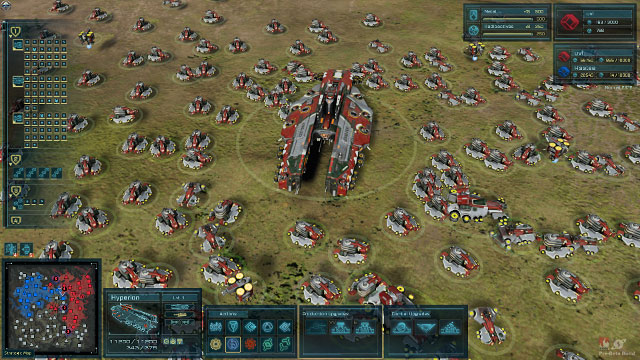
At this stage the graphics are not impressive. They certainly don't meet the expectations set for the first game using DirectX 12. Particularly ugly is the terrain; a notch better are the rather detailed units. On the other hand, all kinds of shots, explosions, lasers and other special effects are quite pleasing. A rather high potential of the game can also be seen when it comes to larger clashes – the numerous effects of the attacks are a sight to behold, and despite the scale of the battle the game, impressively, runs smooth all the time. I found the soundtrack quite appealing as well. Still, there's a couple of glitches in terms of units and alert sounds (although some of them improved with the last update). Even though the game is hardly jaw-dropping on the technical side, I feel that its final version is likely to win the hearts of players.
After seeing the material provided as part of early access, we can be sure of one thing – Ashes of the Singularity is intriguing and definitely encourages us to give it a chance. When looking at the list of things that the developers want to implement, we will notice that the title still has a long way before the full version ends up in our hands. We can therefore safely assume that if it is already able to provide a lot of fun (as well as challenge), the end product should be even better. For fans of futuristic RTSs or battles carried out on a massive scale it is a must-see, whereas connoisseurs of sophisticated strategy and players who are fond of fast, more arcade action, might want to turn their attention to other titles.
